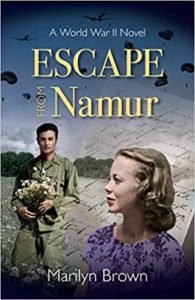 Marilyn Brown introduces her new World War II historical novel, Escape from Namur, and discusses her career writing historical fiction. Marilyn won the first ever AML Award for Novel, for The Earthkeepers in 1980, served as AML President in 2000-2001, and was presented with the Smith-Pettit Award for Outstanding Contribution to Mormon Letters in 2011. She also wrote the words to “Thy Servants Are Prepared” which is included in the 1985 Hymns of The Church of Jesus Christ of Latter-day Saints (#261).
Marilyn Brown introduces her new World War II historical novel, Escape from Namur, and discusses her career writing historical fiction. Marilyn won the first ever AML Award for Novel, for The Earthkeepers in 1980, served as AML President in 2000-2001, and was presented with the Smith-Pettit Award for Outstanding Contribution to Mormon Letters in 2011. She also wrote the words to “Thy Servants Are Prepared” which is included in the 1985 Hymns of The Church of Jesus Christ of Latter-day Saints (#261).
If someone ever asks what I like so much about the Church of Jesus Christ of Latter-Day Saints, I tell them that, besides connecting us with the Savior, one of its greatest assets is its history! And I am in awe of the encouragement it gives us to write our own life stories. There is nothing like the truth as we see it from our own pens. I graduated with the BA (1962) and MA (1964) from Brigham Young University in history and English, and from the University of Utah with the MFA in creative writing (1992). The combination was perfect for me, as I began with excitement to apply the literary arts to the stories of my heritage.
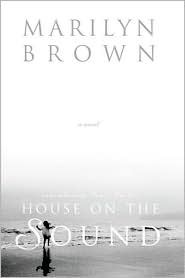 Two of my novels (both winners in Utah State Fine Arts novel competitions) tell the story of my childhood. House on the Sound describes my family’s years in Bremerton, Washington, after we moved from Denver where I was born in 1938. My father worked at the Navy Yard during World War II. I can still remember the balloons on cables, and the blackouts. After my parents were baptized in Puget Sound, they relocated the family—by then including my sisters Elaine and Sylvia —to Provo. Road to Covered Bridge recounts our adventures in Provo during the latter part of World War II. From there the family returned to Denver, where our only brother, David, was born.
Two of my novels (both winners in Utah State Fine Arts novel competitions) tell the story of my childhood. House on the Sound describes my family’s years in Bremerton, Washington, after we moved from Denver where I was born in 1938. My father worked at the Navy Yard during World War II. I can still remember the balloons on cables, and the blackouts. After my parents were baptized in Puget Sound, they relocated the family—by then including my sisters Elaine and Sylvia —to Provo. Road to Covered Bridge recounts our adventures in Provo during the latter part of World War II. From there the family returned to Denver, where our only brother, David, was born.
By the time I was ten, I had an unwavering testimony of the Church of Jesus Christ of Latter-Day Saints. I loved to read, and George Eliot’s Adam Bede, a novel about a spiritual clergyman, became my favorite. I questioned, “Where are the well-written stories like this one, illuminating the lives of the early leaders of our wonderful Church?” There were some works by Nephi Anderson, and a few others. But I was hungry for exceptional quality. It was Eliot’s inspiration that sparked my desire to fill that gap.
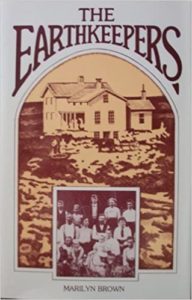 After I graduated from Denver’s East High School, I enjoyed studying creative writing at Brigham Young University, where I won the school’s first Mayhew Award. And when my book The Earthkeepers won the first novel prize ever given by the Association for Mormon Letters, I felt very honored. I was also surprised at a League of Utah Writers’ conference to win first prize in both poetry and short story, and excited when the story was published in Dialogue! I had a few second prizes, too, one for a short story about Vern Law, the national baseball pitcher, and another AML poetry award, for the poem “Grandmother”, which I treasured because it was an honorable mention that I shared with a teacher I greatly admired, Marden Clark.
After I graduated from Denver’s East High School, I enjoyed studying creative writing at Brigham Young University, where I won the school’s first Mayhew Award. And when my book The Earthkeepers won the first novel prize ever given by the Association for Mormon Letters, I felt very honored. I was also surprised at a League of Utah Writers’ conference to win first prize in both poetry and short story, and excited when the story was published in Dialogue! I had a few second prizes, too, one for a short story about Vern Law, the national baseball pitcher, and another AML poetry award, for the poem “Grandmother”, which I treasured because it was an honorable mention that I shared with a teacher I greatly admired, Marden Clark.
About this time I entered a contract with Bookcraft for my novel, And Some must Die. It was about the Willie Handcart Company. But I wasn’t satisfied that it was my best, so I withdrew it. Editing at the BYU Press, I wrote a history of Provo, and decided to write The Earthkeepers.
In 1979 my real estate husband Bill (we married in 1975) helped publish 5,000 copies of The Earthkeepers. Bill’s wife had passed away leaving five young children, and by that time I had one daughter, Simeen, (1967) from a short marriage to a talented musician, Lloyd Miller, in the 1960s. So I was busy with six children, and I had no idea how to market my books. I was so overwhelmed with the responsibilities of a large family that I escaped to Cedar 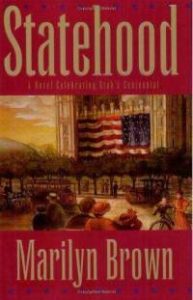 Fort, inc., where I worked as an editor in exchange for CFI’s help in publishing and re-publishing several books, including three of my Christmas novels, and Goodbye, Hello, which became Light in the Room. Statehood was about Utah’s struggle to join the United States, and I rewrote Ghosts of the Oquirrhs, which became The Accidental Goodbye, set in Mercur, Utah, in 1902. I was fortunate to sell quite a few of The Wine-Dark Sea of Grass about the Mountain Meadows Massacre.
Fort, inc., where I worked as an editor in exchange for CFI’s help in publishing and re-publishing several books, including three of my Christmas novels, and Goodbye, Hello, which became Light in the Room. Statehood was about Utah’s struggle to join the United States, and I rewrote Ghosts of the Oquirrhs, which became The Accidental Goodbye, set in Mercur, Utah, in 1902. I was fortunate to sell quite a few of The Wine-Dark Sea of Grass about the Mountain Meadows Massacre.
It was at about this time that my husband needed my help with the Villa, a community theatre in Springville. There we launched ninety-six productions until his heart attack in 2004. I wrote the music, lyrics and books for two musical stage plays: Midsummer Night’s 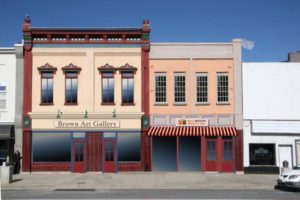 Dream, and The Merry Nutcracker. The Shakespeare musical was later published by an Atlanta company and performed as far as Australia and Vermont. My creative husband, knowing theatre was too stressful for his health, joined me in oil painting. We established the Brown Art Gallery (2008) in Springville, and both of us have sold works and earned awards for our paintings. In 2020 one of my pieces was accepted by the permanent collection at Springville’s Museum of Art.
Dream, and The Merry Nutcracker. The Shakespeare musical was later published by an Atlanta company and performed as far as Australia and Vermont. My creative husband, knowing theatre was too stressful for his health, joined me in oil painting. We established the Brown Art Gallery (2008) in Springville, and both of us have sold works and earned awards for our paintings. In 2020 one of my pieces was accepted by the permanent collection at Springville’s Museum of Art.
In the meantime, Fires of Jerusalem, based on the story of the Old Testament prophet Jeremiah, was published by Beth Bentley’s Parables Publishing. I also wrote a novelization to Richard Dutcher’s movie Brigham City, titled Serpent in Paradise, and made a connection with Covenant Communications to publish The Earthkeepers in three volumes. I found that most LDS publishers were not interested in literary work because of limited audiences and sales. But I was determined. I started the Marilyn Brown Novel Award, a writing contest, which was doing well until entries dried up. Our endowment now funds a successful writing scholarship at Utah Valley University. I was also honored to receive a Lifetime Achievement Award from the Whitney Awards, and to receive, with my husband, a SCERA Star Award for lifetime achievement in the arts.
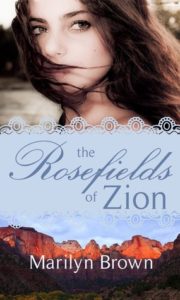 I kept working on my goals, but in 2011, I finally hit a lucky break when I discovered Walnut Springs Press. I felt so grateful to find someone locally who not only understood my aspirations, but could edit! So with the help of enthusiastic, experienced editor, Linda Prince, I have published five novels: The Rosefields of Zion (Set in 1925, near Zion National Park),Waking in Tombstone (set in the 1880s in Tombstone, Arizona), The Accidental Goodbye (set in Mercur, Utah, 1902, a revised version of my 2002 novel Ghosts of the Oquirrhs), Road to Covered Bridge, (an
I kept working on my goals, but in 2011, I finally hit a lucky break when I discovered Walnut Springs Press. I felt so grateful to find someone locally who not only understood my aspirations, but could edit! So with the help of enthusiastic, experienced editor, Linda Prince, I have published five novels: The Rosefields of Zion (Set in 1925, near Zion National Park),Waking in Tombstone (set in the 1880s in Tombstone, Arizona), The Accidental Goodbye (set in Mercur, Utah, 1902, a revised version of my 2002 novel Ghosts of the Oquirrhs), Road to Covered Bridge, (an 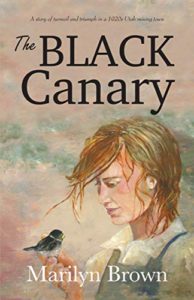 autobiographical novel set in Provo, Utah, in the 1940s, it was expertly reviewed by Harlow Clark for AML), and The Black Canary (set in 1920s Helper, Utah, one of my favorites). With Walnut Springs’ continued support, I am so grateful that several of my novels have been distributed by Deseret Book Wholesalers and carried in the Latter-day Saint bookstores.
autobiographical novel set in Provo, Utah, in the 1940s, it was expertly reviewed by Harlow Clark for AML), and The Black Canary (set in 1920s Helper, Utah, one of my favorites). With Walnut Springs’ continued support, I am so grateful that several of my novels have been distributed by Deseret Book Wholesalers and carried in the Latter-day Saint bookstores.
My latest, a World War II novel, Escape from Namur, is based on a recording by Ida Gilbert Cailteur, the Belgian mother of Jacqueline Wortham, a dear missionary friend my husband Bill and I met while on our mission in St. George. A gracious widow, Jacqueline is now married to a man who lost his wife, the handsome U.S. Air Force pilot, Wilbur Wortham. Brother Wortham’s son, who was serving a mission in Belgium, introduced the couple, and they fell in love through letters. Together, they have served eleven full time missions. Though I believe that adding some imagined detail or literary art holds interest better, the story of Ida/Annie adheres so closely to what actually happened that I included her recorded words at the end. When the Nazis invaded Namur, Ida/Annie and three members of her family began a terrorizing journey through southern Belgium and France. Exhaustion, hunger, and bombs were obstacles to their safety. The story is a dramatic tale of endurance and love. The book is available online at Deseret Book and Amazon.
I am grateful to my local writing friends, Lynne Larson and Veda Hale, and I am indebted to Andrew Hall for his unwavering interest in accurate literary recordkeeping. In addition, I am very grateful to the Church for adhering closely to the truth in their popular volumes of Saints, and to our many Church historians who have spent endless hours struggling to reveal the facts of our history. My work is to add narrative skills to these astute factual records, hoping to offer more compelling accessibility to readers. I am at work now on James S. Brown, who joined the Mormon Battalion, found gold at Sutter’s Mill, and served eleven missions. I hope to tell many more stories about our ancestors that will stimulate interest in what has gone before in an era of faithfulness and courage.
Book blurb:
ESCAPE TO NAMUR is a true World War II story based on an audio recording made by Ida Gilbert Cailteur, the Belgian mother of Jacqueline Wortham, a special missionary friend Bill and Marilyn Brown met on their mission to St. George.
When the Nazis invaded Namur, three members of the Cailteur family began a terrorizing journey through southern Belgium and France. Exhaustion, hunger, and bombs were obstacles to the refugees’ safety. The story is a dramatic tale of endurance and perseverance. A novelist, author Marilyn Brown unleashes her skills to build a dynamic historical fiction. The book is available through Deseretbook.com and Amazon.com.
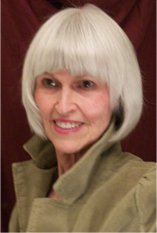 Title: ESCAPE FROM NAMUR
Title: ESCAPE FROM NAMUR
Author: Marilyn Brown
Historical Fiction
294 pages. Paperback, $17.99
ISBN—13-978-1-59992-268-3
Published by Walnut Springs Press
Distributed by Deseret Book Wholesalers
Available at Deseretbook.com, Amazon.com, and Latter-day Saint bookstores
Contact: marilynmcmeenbrown@gmail.com

One thought